Blu-ray Review: FOREVER MARILYN - 7 Discs De-Mythologize Cinema Icon
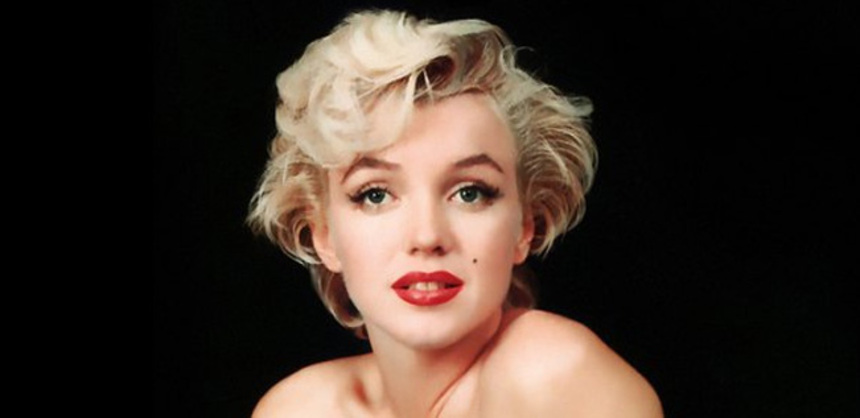
It's impossible, of course, for anyone born after her death to see Marilyn Monroe as anything less than an icon of a certain age of cinema. Her pursed, glossy lips, glorious curves, alabaster skin and platinum hair make for a particular bombshell look, one that's almost too fanciful, almost clown-like to take seriously. Out of context of her actual performances, she's a mix of tabloid drama and pin-up dream girl, someone whose porcelain visage was as fragile as her emotional state. The breathy voice, whispering seductively or singing for the likes of sitting presidents, have formed a kind of religious canon around the actress.
My introduction to the other side, the Norma Jean side of Monroe, was courtesy of some clever lyrics by Bernie Taupin. Before being re-purposed by a live version from Australia, or the bastardized lyrics to commemorate the death of a princess, the notion of Marilyn being "more than a sex symbol" was brought to light with a simple song off of Goodbye Yellow Brick Road. Elton sings about "Hollywood creat[ing] a superstar, and pain was the price [she] paid", and that even after her untimely death "the press still hounded [her]. All the papers had to say was that Marilyn was found in the nude."
Until receiving this set, I'd never seen a single Monroe
film.
Sure, I'd been subject to hundreds of photos, clips of this or that performance, drag shows,
Madonna's appropriation of the image, TV's Smash, even the first issue
of Playboy, and I'd never seen the woman act, in context, with an ensemble of
actors.
I'd never, in short, seen what really made Monroe such a star.
For beyond the image, the fragility, the visits to hospitals
and string of disappointments, beyond the decades of hype and expectation, I
found myself at times quite smitten with her onscreen charisma. Underneath the
hyperbole and hysteria, there was clearly a person that the camera absolutely
adored.
Curvy beyond modern reckoning (her "size 12" referenced in Misfits would be positively obese by today's bulimic standards of plastic starlets), she played vapid with intelligence and vulnerable with a strength of character.
With each of the films in this collection, we see different sides of the actress, used by some of the most esteemed directors in the history of the medium, paired with some of the finest actors that cinema has ever seen. Marilyn's performances in this collection are not always the highlight of each particular work, but in their own way they tie these disparate films together in a way that they normally wouldn't be associated.
On and off-set dramas contribute to her myth, yet for the most part her on-screen persona is presented free of any of the turmoil that was transpiring off camera. Sure, she was subject to the whims of her parade of managers and coaches, her preternatural lateness the cause for much tension, her unreasonable demands masking a deep, bitter and brutal depression. Yet it is in these roles that her immortality stands, roles drawn out by sometimes patient, sometimes masochistic directors willing to sacrifice time and expense to get a little bit of her gold on screen.
It's impossible to forget about the destruction going on off screen for the entirety of these films, but for the most part one can blithely ignore the well-tread stories and concentrate instead on that magnetic smile, her quick wit, her impeccable physicality and (frankly) magnificent physique, and simply sit back and enjoy the films. For the movies, like Marilyn herself, are among Hollywood's finest productions.
Beyond the hype, beyond the allusions and references and
remakes and remarks, there was a star named Marilyn who managed to make a
number of the most fun, most entertaining films of her generation. It's nice,
at long last, to see the woman for what she was on screen, not a mere plaything
of male desire, but a genuine actress with range and ability, more than mere
sexpot or subversion of the staid code of 50s cinema.
The Discs
With the release of the aptly titled Forever Marilyn, Fox has collected seven of her more celebrated roles (including a couple from the MGM library). From Cinerama classics to down-and-dirty character pieces, from fluffy musicals to timeless comedies, this collection does a remarkable job at conveying some of what made Marilyn so beloved at the time, and why her stardom continues to radiate decades later.
I watched the films in chronological order, and save for the extremely celebrated Billy Wilder vehicle, Some Like it Hot, I was pretty much unaware of either the fellow cast or production staff on any of these films. Going through the set was like attending a strange kind of film festival, each film disparate in its own way, with its only common thread a single actress. On their own, most of these films are well deserving of their own appreciation, and often Marilyn herself isn't the driving force of either the story or the charms of the film itself.
It may be a side effect of her stardom that we've seen these films presented in such fine gigh definition fashion, but it's a welcome one. Without Marilyn many of these films would have been forgotten, or at least sidelined with dozens of other works of equal value. With her inclusion, they're part of a unique canon of works tied to this megastar, and as such we're lucky enough to enjoy them tied to her celebrity, yet free from (most) expectations about genre, story line, etc.
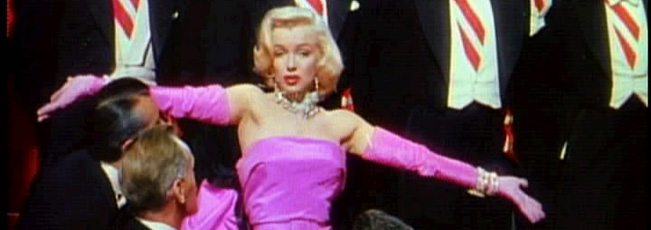
Gentlemen Prefer Blondes (1953)
This can easily be summed up as the "Diamonds Are a Girl's Best Friend" movie, as Monroe teams up with Jane Russell to score a man aboard a cruise ship. The fact that it's directed by Howard Hawks, one of Hollywood's finest and most prolific, was just one of many pleasant surprises I found exploring this set.
Russell, like Marilyn, was pretty much simply an icon for me, a pin-up doll from the War period that set the hearts of many a serviceman ablaze. Marilyn's terrific in this trifle of a film, but it's Russell that really sizzles, completely outfoxing her co-star in the sexiness department. We're told to prefer blondes, but in this case the sassy and sardonic Russell completely steals the show from the overly affected wispiness of the young Monroe.
There are song aplenty, and the celebrated key number (mimed by Madonna and Moulin Rouge alike) remains an absolute hoot, particularly in the context of the (loose) narrative.
Shot in sumptuous Technicolour, this is a glossy-lipped
cavalcade of early 50s colour cinema, with Monroe's pink dress set against a
blood red background just one of the more outrageous choices the production
staff makes with this film.
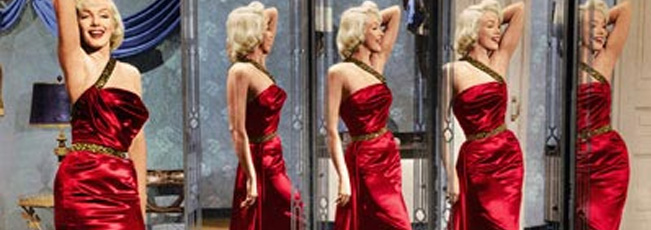
How To Marry a Millionaire (1953)
This was the first of several of films on this set that I'd never even heard of. Directed by the equally obscure-to-me Jean Negulesco, this was a film that I'd be unlikely to seek out under any other circumstance, making its inclusion in the set all the more pleasing. Monroe teams up with Betty Grable and the exceptional Lauren Bacall. Continuing the gold-digging narrative from the previous film, here we have made explicit the desire for a group of three young women to hoodwink their way into richness.
The opening of the film is a five minute overture where we see Alfred Newman (composer of the stirring Fox theme that always beckons to me of the opening moments of Star Wars) and his symphony swinging through the theme from "Street Scene". Ostensibly a show-off of the stereophonic sound tied to the (then) new Cinemascope process, I quite adored this little bit of gratuitous vintage ostentation.
The story is of course pretty silly, but there's a dry wit to the whole affair that's quite captivating. Sly nods to real life affairs with older men (Bacall's reference to that old guy who's in African Queen, for one) makes the playful dialogue all the more pleasing.
Monroe here is at her most slapstick, yet she looks positively adorable in her horn-rimmed glasses. The scene in an airplane, where she has confused Atlantic and Kansas cities, is one of her finest, her comic timing impeccable and her charm downright intoxicating.
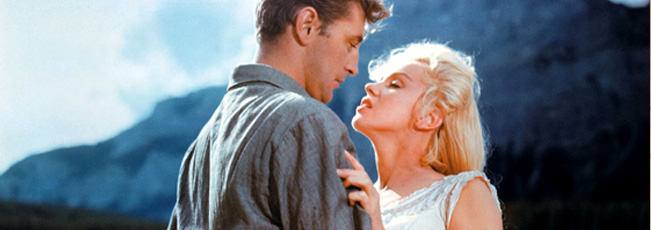
River of No Return (1954)
Another film well off my radar, I was again pretty shocked to see the likes of Otto Preminger's name showing up as the mind behind one of the works of this set.
Alas, the film is a bit of a mess, despite some extremely fine caliber talent. Robert Mitchum remains a power presence as a pioneer settler who gets taken advantage of by Monroe's beau played by Rory Calhoun (his second appearance in this set, showing up as Grable's catch in the previous film). If I knew little of Marilyn, it's safe I knew less of Calhoun, save for a delightfully insane reference from a Simpsons episode, as well as his turn in 1984's Angel, a film I proudly own on Laserdisc.
Regardless, the issue of the film is one of plot, with a fairly preposterous story made all the more dated by the causal sexual assaults and preposterous portrayals of the aboriginals. Still, there are moments of great beauty in both the scenery and performance, and Monroe's early musical performance in a room full of prospectors is a seductive delight.
What's key as well is that we see Monroe free from the usual trappings of elegance and overly-made up glamour that the previous films tread upon. Made all the more, well, "real", she remains an incredibly beautiful presence on screen, almost more so scrubbed from the heightened gloss that removes any sense of naturalism from her face. Her range in this work is still a little stilted, but in shows a charismatic side of her free from ball gowns and big production numbers.
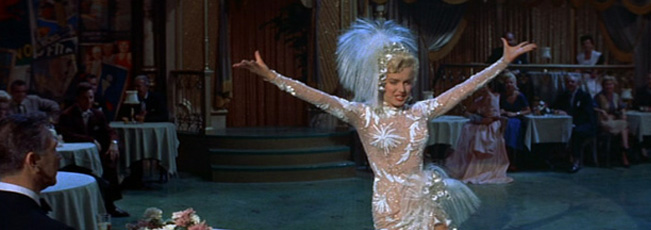
There's No Business Like Show Business (1954)
Monroe's inclusion in this film is as a kind of stunt casting - she plays a critical role, to be sure, but it's not as if the entirety of the plot surrounds her plight. Directed by Walter Lang, who would go on to great success with his next film, The King and I, TNBLS is really is a film showcasing Ethel Merman and Donald O'Connor. Just a few years after Singin' In the Rain, O'Connor tries (unsuccessfully, alas) to parlay that charm of that other "jukebox" film into another hit. Merman belts out in her squaky but tuneful way hits from a number of her celebrated roles, including the title song that she made famous on stage in Annie Get Your Gun.
Cruising through a number of Irving Berlin numbers, Marilyn shows up as a beautiful distraction to young Mr. O'Connor, and she gets her chance to shine with a particularly libidinous take on "Heatwave".
This was the beginning of the end for Marilyn, and while some of that darkness shows through in some of the lighter moments, she's still more than capable of being the pretty blonde who sweeps a young hoofer off his feet. Fluffy, forgettable fun, it's a fine testament to the talents of Merman and O'Connor, and a lesser film for Monroe.
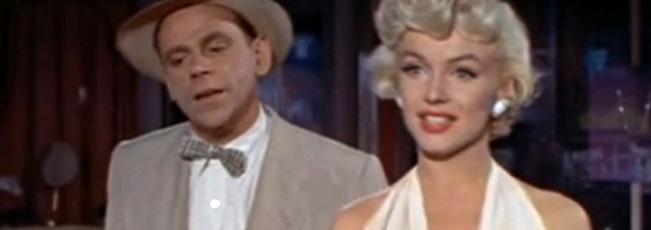
The Seven Year Itch (1955)
This is the first of two films on this set directed by Billy
Wilder, and despite its fine reputation I found it to be a bit of a dud. This despite a nifty title sequence by Saul Bass, and some of the more memorable scenes of Monroe's career.
Tom Ewell plays a neurotic New Yorker who sends his wife and child away for the summer, only to be struck (almost literally) by his upstairs neighbour played, of course, by Ms. Monroe.
Eschewing voice over for monologue, the scenes of Ewell talking to himself aloud are distracting and clunky, and the story itself is more broad and preposterous than it needs be. There are some delightful side characters, to be sure, and Marilyn herself is quite radiant during this period, shot with a great sensitivity by the director.
Of course, this will always be known as the film with "that" scene, a blustery shot of Marilyn standing atop a subway grate. After having seen the image a million times, was amused to see that the exact images doesn't appear in the film. Instead, we get a couple medium shots - her legs, her fluttering hair, but never the shot of her, mouth agape, lost in the pleasure of the breeze running up her legs.
This is of course as close to socially acceptable raw sexuality came in the 50's, and the image remains a potent one. That famous white dress and her gravity embracing cleavage are indelibly part of cinematic history, and while the film as a whole doesn't quite gel, it clearly has its moments for it iconographic star to be particularly luminous.
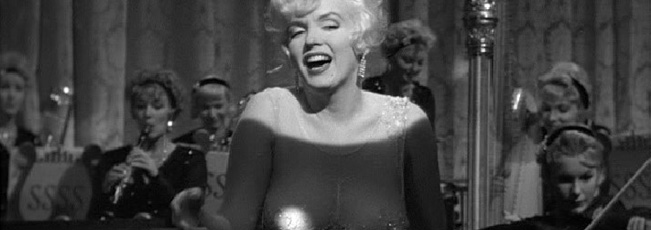
Some Like It Hot (1959)
It's been said that Billy Wilder wanted to shoot Itch in black and white, but Monroe's contract stipulated that all her films were to be in colour. I had actually forgotten from the brief clips of Some Like It Hot that I'd seen that Wilder won out with this film, for reasons apparently associated with how the two male stars looked in drag on colour stock.
This was the film I was most looking forward to finally seeing, and it did not disappoint in the least. This is an astonishingly great movie, breezy and boisterous, as charming and fresh as the day it was made. Where Itch seemed tired and dated, this film brims with exuberance.
Monroe, it must be said, looks unabashedly, ridiculously amazing in this work. Slightly heavier than normal (she was apparently either pregnant or had recently miscarried), her extra curvature makes her pallor seem healthier, the black-and-white palate doing wonders for providing a sense of both seduction and sensuality. With this film alone I get the fascination, the genuine lust that an entire film going generation had for this star. From "that dress" during the musical number (one of the finest special effects/acts of misdirection in the history of cinema, I dare say), to the lustful grinding against Tony Curtis, this is hot stuff indeed.
Yet, despite the obvious, jaw-dropping looks of Monroe, it never seems to delve into tawdriness.
To say that Lemmon and Curtis are wonderful in this film is to add to an already pretty full chorus that has praised this film for years. Listed tops of the AFI list of Comedies, and in the top 25 of any American film of all time, the plaudits certainly seem well deserved. If there's one film in this set I'm sure to re-watch over and over it's this, an impressive collision of theme and genre, wonderful character actors, with a bristling script that's unafraid to leave 20 minutes before the introduction of one of our leads, or to leave an hour gap between critical plot moments, only to have them effortlessly reintegrated into the tale.
Some Like It Hot may be the definitive Monroe film, the one you should see to see what all the fuss is about. You want to both hug her and ravish her, her fine line between innocence and hardscrabble, world wearied alcoholic is crafted gently. Sure, she took a bazillion takes to get things right in some instances, but my gosh, shouldn't we be pleased that the result is there on screen to enjoy for eternity.
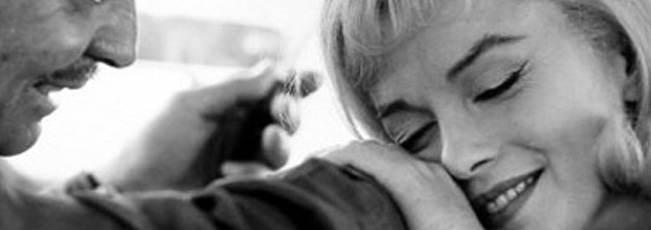
The Misfits (1961)
Another black-and-white film fills out the set. Misfits once again brings giants of the screen to the table - this is not only the last film that Monroe ever shot, but it also stars Clark Gable (in his own final role, as he died days after filming), Eli Wallach and Montgomery Clift, is written by Monroe's former husband Arthur Miller, and was directed by John Huston.
The film is a mishmash of parables and metaphors, finding a group of three men each in their own way in love with Monroe's divorcée character, culminating in them rounding up wild horses in the Navada desert.
This was clearly near the end for Monroe, yet it's among her finest performances. If River had her lean towards the natural look, this shows off Marilyn's scrubbed-free beauty like no other film in this set. She's effortlessly gorgeous in this film, yet conveying such sadness and madness that it's hardest here to separate the role from her very public descent towards full depression.
If the roles appear a bit heavy handed, and the setting more than a bit claustrophobic despite the grandeur of the wide desert, it's nonetheless entirely believable that an emotional and unstable Monroe would be able to twist to her liking the behaviour of certain hard men.
It's unclear what the final message of the film is meant to convey other than what's superficially a quite trite conclusion, but suffice it to say, the film plays out with a great deal of conviction and style. Stark images of bound and sweating horses against the desert sands, or an extremely wide shot of a raving Monroe screaming about injustice are but some of the more memorable images Huston and co. managed to capture.
This isn't a film to love like some of the lighter fare, but it's a powerful work, with Monroe absolutely equal to her compatriots in the telling of this raw, often tumultuous tale.
Video/Audio
Each film in the set has different levels of both audio and video presentations, but even the lesser known films have fairly fine high definition presentations that make for a great addition to any collection.
Gentlemen Prefer Blondes looks positively gloss-tastic, probably due to a bit of scrubbing of the negative through automatic processing. Still, it's hardly a heavy handed process, and save for a few moments where it looks like the picture veers towards the video-y, it's clear that this film isn't going to look too much better in the home environment any time soon.
The soundtrack has been expanded to 5.1 (as has most of the rest of the discs), and in this instance the lushness of the score does well to be opened up in this fashion.
How To Marry a Millionaire looks half its age in this
sublime Cinemascope presentation. In fact, the only real issues you'll notice
are colour distortion when certain cross dissolves are performed, a facet that's
shared by all the colour films in this set and indicative of the way that such
optical transitions were accomplished during this period via multiple
generation printing.
Cinemascope was originally a 4 channel audio presentation, and whether they
used this original mix or simply expanded the stereo into 5.1, it sounds pretty
darned good.
Audio wise, the same can't be said for River of No Return. Almost certainly due to the original source recordings, there's an echo-y sound to much of the dialogue which is quite distracting. I found myself switching between the stereo (with Dolby processing engaged) and the 5.1 lossless mix to try to find the best and least distracting mix possible. I soon just reverted to the on-disc surround track, and stuck with it.
Visually, the film looks as tremendous as the previous Cinemascope film, not quite up to the standards of a frame-by-frame restoration, but still very, very good. Real projection elements of Monroe on the river are clearly delineated from the actual outdoor shots, so sometimes that clarity comes at a cost of believability for vintage films like this.
There's No Business Like Show Business is a studio spectacular, and that kind of indoor look is a kind of let down after the previous two widescreen epics. Still, the film looks and sounds pretty great for its vintage.
The Seven Year Itch looks particularly great, save for a few very minor specks. The clarity is such that you can see the mild soft-focus that Wilder employed on Monroe, and can also tell immediately that the famous subway grate scene is shot on a studio. Sound wise, it's mostly dialogue and some fine score/diegetic music, and it all works as well as one would hope.
The Misfits looks pretty exceptional, especially given that it's a relatively "lesser" film in the set. Its soundtrack drops the fake surround and goes for what's essentially a mono mix.
Supplements
Save for one of the discs, the so-called "extras" are pretty lacking on many of these titles. Most titles contain trailers for the other films on the set, or the odd Movietone short clip. It appears there was a PBS documentary on the making of Misfits that would have been a fine inclusion on that disc.
The two Wilder films get their share of proper attention.
On Seven Year Itch there's a Hays Code: Picture-in-Picture with Sexual Innuendo Meter which has to be one of the more stupid additions ever made to a film. The timeline on Monroe is also pretty silly, stretching at attempts of providing "interactivity" on disc.
The commentary by Kevin Lally works a lot better. As a biographer of Wilder, Lally puts into context the film and its challenges with a puritanical, censorious mid-50s cinema environment.
There a short, decent doc called Monroe and Wilder: An Intersection of Genius which brings together some usual suspects to talk about the film. I do kind of adore the fact that Hugh Hefner is one of the go-to guys to talk about all things Marilyn.
There's a 20 minute or so Legacy doc with Producer Tom Rothman, and a couple Deleted Scenes provided in Standard definition. We get some stills, some more Movietone clips, and a fluffy "Hollywood Backstories" piece that does little to add to what was already said elsewhere.
Some Like It Hot has a similar range of added bits. First there's a chatty commentary with Paul Diamond, kid of original screenwriter I.A.L. Diamond. He's joined by Lowell Ganz and Babaloo Mandel, the team behind Parenthood, City Slickers, and a slew of other flicks, who are only here because they like the film so damn much. There's a few funny bits (including where Diamond admits to a story about as a kid on set calling Marilyn "fat"), but it's a pretty uninformative track. Additional comments culled from interviews with Tony Curtis and Jack Lemmon are also interspersed.
There's a couple short docs (Making Of, Legacy), each about 20 minutes that go into some superficial detail about the production. Of note are inclusions of interviews with both Diamond and Wilder, talking frankly about Marilyn, the shoot, and the challenges of making the picture work.
Leonard Maltin sits down with Curtis for a Nostalgic Look Back - it's a ribald little chat, and we get some great moments with the man born Bernie Schwartz as he spills the beans about his time on set.
The Memories from the Sweet Sues sees four of the "girls" from the band reminisce - it's a nice little addition, but hardly epic.
Finally, there's a trailer, as well as a particularly annoying "Hall of Memories" that's a poor excuse for a photo gallery.
In conclusion
In spending the last couple weeks living with these films, I've come to appreciate the talent that lay at the core of the mythology of Marilyn. While there's only one truly ground breaking, timeless film in the set, this collection from Fox is an exceptional foray into a part of film history that I frankly haven't spent nearly as much time appreciating. Without being associated with Marilyn, I'd have missed the fun of Bacall in Millionaire, or the somber sonority of Mitchum in River. I had a chance to have a mini film festival with these works, and it's been a pleasurable little curated take on this period of cinema history.
At a relatively reasonable price, the set is pretty much a no-brainer - plenty of films may be outside your comfort zone, and I would have liked better supplements on some of the titles, but I can't help but be extremely pleased with the fine presentation of these little film gems. From a comic masterpiece to a maudlin melodrama, we still get in these seven films a great insight into the charisma of one of celluloid's most potent icons, and can witness through film-to-film something quite sublime coming through the screen.







